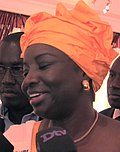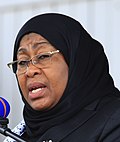| Portrait | Head of government or state | Country | Status | In office
(first time) |
|---|
 | Benazir Bhutto |  Pakistan Pakistan | Prime Minister of Pakistan | 2 December 1988 – 6 August 1990
18 October 1993 – 5 November 1996 |
 | Khaleda Zia |  Bangladesh Bangladesh | Prime Minister of Bangladesh | 20 March 1991 – 30 March 1996
10 October 2001 – 29 October 2006 |
 | Tansu Çiller |  Turkey Turkey | Prime Minister of Turkey | 25 June 1993 – 6 March 1996 |
 | Sheikh Hasina |  Bangladesh Bangladesh | Prime Minister of Bangladesh | 23 June 1996 – 15 July 2001
6 January 2009 – 5 August 2024 |
| Mame Madior Boye |  Senegal Senegal | Prime Minister of Senegal | 3 March 2001 – 4 November 2002 |
 | Megawati Sukarnoputri |  Indonesia Indonesia | President of Indonesia | 23 July 2001 – 20 October 2004 |
 | Roza Otunbayeva |  Kyrgyzstan Kyrgyzstan | President of Kyrgyzstan | 7 April 2010 – 1 December 2011 |
 | Atifete Jahjaga |  Kosovo Kosovo | President of Kosovo | 7 April 2011 – 7 April 2016 |
 | Cissé Mariam Kaïdama Sidibé |  Mali Mali | Prime Minister of Mali | 3 April 2011 – 22 March 2012 |
 | Sibel Siber |  Northern Cyprus Northern Cyprus | Prime Minister of Northern Cyprus | 13 June 2013 – 2 September 2013 |
 | Aminata Touré |  Senegal Senegal | Prime Minister of Senegal | 3 September 2013 – 8 July 2014 |
 | Ameenah Gurib-Fakim |  Mauritius Mauritius | President of Mauritius | 5 June 2015 – 23 March 2018 |
 | Halimah Yacob |  Singapore Singapore | President of Singapore | 14 September 2017 – 13 September 2023 |
 | Samia Suluhu |  Tanzania Tanzania | President of Tanzania | 19 March 2021 – Incumbent |
 | Vjosa Osmani |  Kosovo Kosovo | President of Kosovo | 4 April 2021 – Incumbent |
 | Najla Bouden [1] |  Tunisia Tunisia | Prime Minister of Tunisia | 29 September 2021 – 1 August 2023 |
 | Sara Zaafarani |  Tunisia Tunisia | Prime Minister of Tunisia | 21 March 2025 – Incumbent |